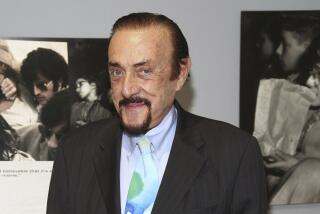Real doctor behind ‘Stanford Prison Experiment’ talks about dark side of power
- Share via
What causes seemingly good, ordinary people to go bad? In 1971, psychology professor Philip Zimbardo took a crack at that question with his infamous Stanford Prison Experiment, enlisting two dozen student volunteers as prisoners and guards in a simulated jail to examine the dark side of power.
Four and a half decades after the study spun out of control, director Kyle Patrick Alvarez’s “The Stanford Prison Experiment,” a narrative film created with Zimbardo’s input, is bringing the story to the big screen with little poetic license taken — or required.
“Nothing in the movie is exaggerated,” Zimbardo said in a recent phone interview.
In order to get clearance to use the Stanford name in the title, Zimbardo said the university had to approve Tim Talbott’s script. Fortunately for the filmmakers, the actual events of the experiment offered plenty of drama.
With precise attention to detail and a documentary-like aesthetic, Alvarez’s film opening Friday recounts how the study’s subjects were selected for their mental and emotional stability, arbitrarily designated as guards or prisoners, dressed in rudimentary uniforms and led to a mock jail in the basement of the Stanford psychology department building.
Once there, the guards and prisoners quickly adapted to their roles, with the former displaying sadistic, violent tendencies and the latter becoming submissive and distraught. Punishments endured by the prisoners included being placed in solitary confinement, cleaning toilets with their bare hands, doing push-ups and being stripped naked.
Zimbardo, who participated as the prison’s superintendent, ended the planned two-week experiment after six chaotic days.
“We were all overstressed,” Zimbardo recalled of his small team, which included two graduate students, one undergrad and occasionally an ex-convict serving as a consultant. “It’s clear to me in retrospect we needed a bigger staff, for one. We needed an ombudsman. I slept in my office upstairs. For six days I never left ‘the set,’ if you will. I was overwhelmed by the constant decisions that had to be made, especially when the prisoners started to have breakdowns.”
Though he’s admittedly “not a big film buff,” Zimbardo said the claustrophobic air of the movie effectively conveys a sense of how “psychologically stuck” the prisoners felt.
Anchoring “Stanford” is a committed cast that includes Michael Angarano as a gung-ho guard, Ezra Miller as a rabble-rousing prisoner and Billy Crudup as Zimbardo.
Of his on-screen alter ego, Zimbardo had much praise and only minor quibbles.
“One critique I made of Billy: I come from a Sicilian background and use my hands extensively when I talk, and he didn’t,” Zimbardo said. “He’s too American. And he’s more handsome.”
Zimbardo admitted the film can be disturbing at times. “The question,” he said, “is will enough viewers turn that emotional distress into self-questioning? What kind of guard would I have been? What would I have done in a position of power?”
Zimbardo added, “Some viewers will say it’s overwhelming. I hope it’s socially redeeming.”
Follow @ogettell for movie news
More to Read
Only good movies
Get the Indie Focus newsletter, Mark Olsen's weekly guide to the world of cinema.
You may occasionally receive promotional content from the Los Angeles Times.










